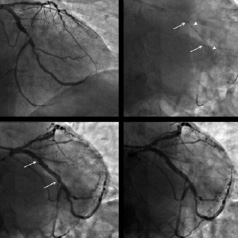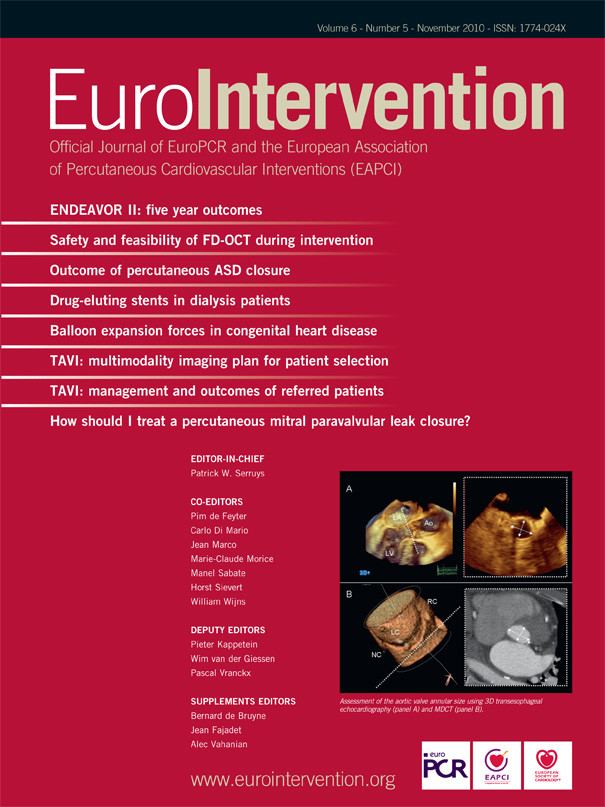“Everything is simpler than you think and at the same time more complex than you imagine.”
Johann Wolfgang von Goethe
We read with interest the paper by Catakoglu and Aytekin describing a novel stenting technique aiming at ensuring side branch (SB) access when treating bifurcation lesions.1 We praise the commitment of the authors to preserve SB access, however, a few points of their strategy deserve some comments. As a first step, the authors recommend to predilate both the main vessel (MV) and the SB. Predilation of a SB without severe atherosclerotic disease is generally not recommended because of the risk of dissection and the subsequent probability to recross, through a dissection plane, a strut which is too proximal with respect to the carina. Bench testing of provisional stenting has indeed shown that rewiring through the strut closest to the carina provides a far better scaffolding than proximal rewiring.2 Accordingly, SB predilation is also discouraged in order to take advantage of the carina shift ensuing MV stenting so that the wire could cross the stent exactly at the carina level. In the highway technique, the incomplete stent expansion in the proximal MV due to the simultaneous inflation of a SB balloon is of concern for distal strut rewiring. Owing to stent underexpansion in the proximal MV, the stent cell which is closest to the carina is likely not facing the SB ostium, thus possibly preventing optimal SB rewiring. Just the opposite, optimisation of proximal MV stent expansion with a slightly bigger balloon (the so called POT, which stands for proximal optimisation technique) has been proposed as a mean to favour SB rewiring through the carina cell.2
Prior to this stage, the highway technique requires both SB balloon and SB wire to be removed. However, jailed wire removal should be avoided until effective recrossing has been performed because it marks the SB, it keeps it open and modifies favourably the angle between the two bifurcation branches.
On the whole, the highway technique is a rather complex approach to improve SB access following provisional MV stenting. In the same issue of EuroIntervention, the description by Burzotta et al of the jailed balloon technique offers a far simpler approach to SB preservation when performing provisional stenting.3 When choosing this strategy, a balloon is just left jailed in the SB during MV stent inflation in order to reduce carina shift in addition to a favourable modification of the bifurcation angle. The jailed balloon helps rewire the SB; in case of an unsuccessful attempt, the jailed balloon may be inflated to displace the carina toward the MV, thus facilitating SB rewiring.
A main concern with this technique is related to the possible risk of balloon entrapment in the SB, which, however, never happened in the authors descriptive series. In this respect, we would like to report an unexpected drawback that we encountered during our learning curve with the technique (Figure 1). Despite high pressure deployment of the MV stent, removal of its delivery catheter pulled the jailed balloon out of the SB due to friction between the stent delivery system and the shaft of the jailed balloon in the guiding catheter.
We guess this harmless event could be reassuring about jailed balloon entrapment.

Figure 1. In a patient admitted because of non ST-segment elevation myocardial infarction, the bifurcation between the left circumflex artery and its marginal obtuse branch was the index lesion. It was classified as 1,0,0 according to Medina and was characterised by a high plaque burden distributed eccentrically toward the side branch (SB), as well as an anticipated high risk of SB closure during main vessel (MV) stenting (upper left panel). A strategy of crossover stenting with jailed balloon protection was chosen. Arrows identify the markers of a 2/20 mm balloon in the SB and arrowheads show the markers of a 3/20 stent in the MV (upper right panel). Post-stenting angiography shows both the markers of the balloon (arrows) being proximal to the bifurcation (left bottom panel). Indeed, despite high-pressure (16 atm) deployment of the MV stent, removal of its delivery catheter inadvertently pulled the jailed balloon out the SB. However, thanks to carina shift prevention by the balloon occupation of the SB ostium, this did not compromise SB patency and a good final result was achieved (right bottom panel).

